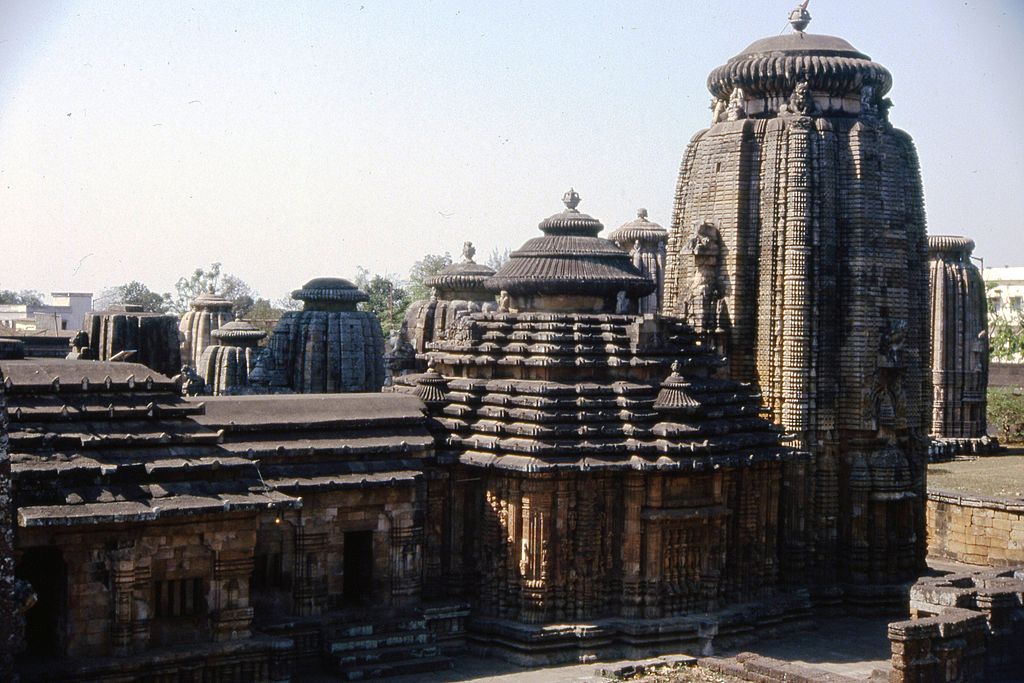ॐ श्री गुरुभ्यो नमः ॐ श्री शिवानन्दाय नमः ॐ श्री चिदानन्दाय नमः ॐ श्री दुर्गायै नमः
Source of all Images in this Blog-post : Google Images : ‘Google Image Search’ will reveal the multiple sources of every single image shared in this Blog. For more details, kindly see ‘Disclaimer‘
Lingaraja Temple is a Hindu temple dedicated to Hindu God Shiva and is one of the oldest temples in Bhubaneswar, the capital of the Indian state of Odisha.

The temple is the most prominent landmark of Bhubaneswar city and one of the major tourist attractions of the state. The Lingaraja temple is the largest temple in Bhubaneswar. The central tower of the temple is 180 ft (55 m) tall.
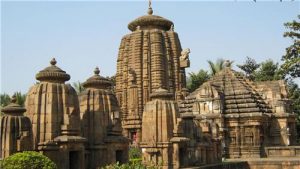
The temple represents the quintessence of the Kalinga architecture and culminating the medieval stages of the architectural tradition at Bhubaneswar.
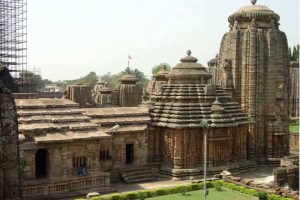
The temple is believed to be built by the kings from the Somavamsi dynasty, with later additions from the Ganga rulers. The temple is built in the Deula style that has four components namely, Vimana (structure containing the sanctum), Jagamohana (assembly hall), natamandira (festival hall) and bhoga-mandapa (hall of offerings), each increasing in the height to its predecessor.

The temple complex has 50 other shrines and is enclosed by a large compound wall. Bhubaneswar is called the Ekamra Kshetra as the deity of Lingaraja was originally under a mango tree (Ekamra) as noted in Ekamra Purana, a 13th-century Sanskrit treatise.
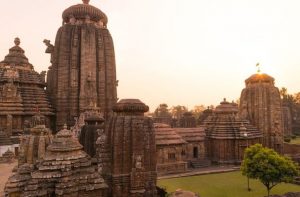
The temple is active in worship practises, unlike most other temples in Bhubaneswar and Shiva is worshipped as Harihara, a combined form of Vishnu and Shiva. The temple has images of Vishnu, possibly because of the rising prominence of Jagannath sect emanating from the Ganga rulers who built the Jagannath Temple in Puri in the 12th century.

Lingaraja temple is maintained by the Temple Trust Board and the Archaeological Survey of India (ASI).

The temple has an average of 6,000 visitors per day and receives lakhs of visitors during festivals. Shivaratri festival is the major festival celebrated in the temple and event during 2012 witnessed 200,000 visitors.
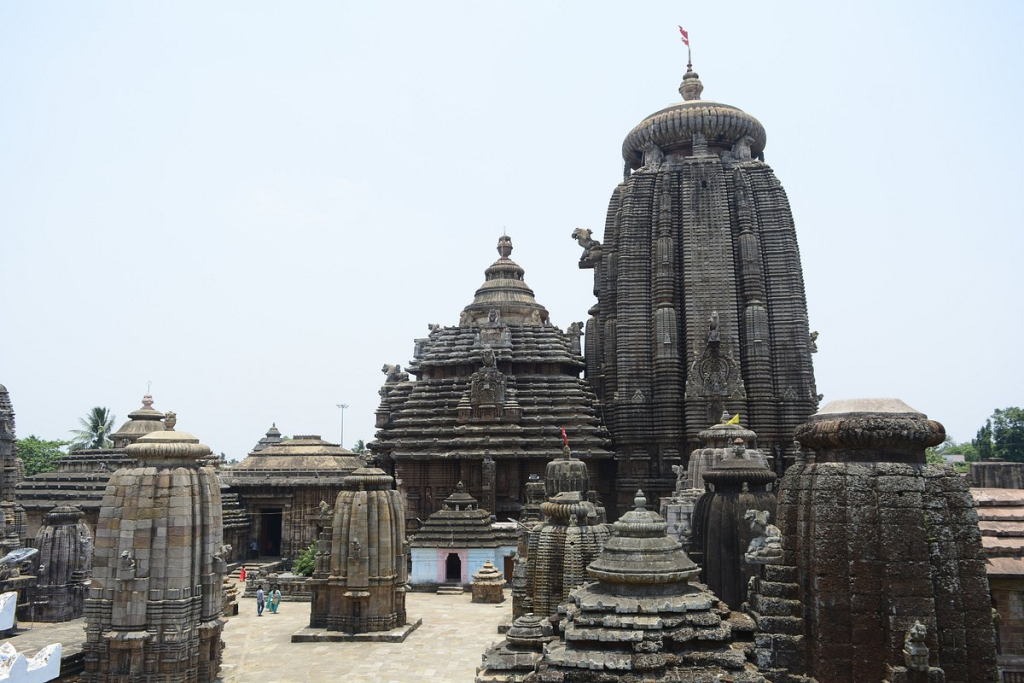
The temple compound is not open to non-Hindus, but there is a viewing platform beside the wall offering a good view of the main exteriors. This was originally erected for a visit by Lord Curzon when Viceroy.

A Few YouTube Videos on Lingaraj Temple, Bhubaneswar :
Architecture
The Lingaraja temple in Bhubaneswar, India, is the largest temple in the city and a prime example of a Hindu temple. It is surrounded by a spacious compound wall made of laterite, measuring 520 ft by 465 ft, with a thickness of 7.5 ft and a plain slant coping on top. The temple faces east and is constructed using sandstone and laterite.
The temple follows the Deula architectural style, which consists of four components arranged in descending height: Vimana (sanctum), Jagamohana (assembly hall), Natamandira (festival hall), and Bhoga-Mandapa (hall of offerings). Each component is aligned axially. The dance hall (Natamandira) is associated with the Devadasi system and is characterized by an increase in height from the hall of offerings to the tower of the sanctum.
The Bhoga-Mandapa, or hall of offerings, has dimensions of 42 ft by 42 ft from the inside, with four doors on each side. Its exterior walls are adorned with decorative sculptures. The hall has a pyramidal roof with multiple horizontal layers and an inverted bell and Kalasa on top.
The festival hall (Natamandira) measures 38 ft by 38 ft from the inside and has one main entrance and two side entrances. Sculptures of women and couples decorate the side walls, and the hall has a sloping flat roof with thick pylons inside.
The assembly hall (Jagamohana) measures 35 ft by 30 ft from the inside and has entrances on the south and north sides. Its roof is 30 meters tall and follows a pyramidal design similar to the hall of offerings. The entrance facade is adorned with perforated windows and lion sculptures.
The sanctum, known as the rekha deula, has a pyramidal tower measuring 60 meters tall over the sanctum, with dimensions of 22 ft by 22 ft from the inside and 52 ft by 52 ft from the outside. The tower is decorated with intricate designs and features seated lion sculptures. Inside the sanctum, the walls are sculpted with female figures in various poses.
The Lingaraja temple also includes a spacious courtyard filled with numerous small shrines.
Religious Significance :
Bhubaneswar, known as Ekamra Kshetra, holds religious significance due to its association with the deity Lingaraja. According to the Ekamra Purana, Lingaraja was originally located under a mango tree called Ekamra. The treatise mentions that during the Satya and Treta yugas, the presiding deity was not in the form of a lingam, but it emerged as one during the Dvapara and Kali yugas.
The lingam in the temple is an unshaped stone known as Krutibasa or Swayambhu, resting on a Sakti. Similar lingams can be found in 64 different places across India. In the early 12th century, with the rise of the Ganga dynasty, the prominence of the Jagannath sect increased, leading to the remodeling of the temple. The Gangas introduced Vaishnavite elements, such as the inclusion of images of Vaishnava Dwarapalas named Jaya and Prachanda. Additionally, the temple’s flag was fixed to a Pinaka bow instead of the trident commonly seen in Shiva temples.
Festival & Worship Practices
The Lingaraja temple in Bhubaneshwar, India is an active worship center and holds significant festivals and worship practices. The Bindusagar Tank, believed to be filled by an underground river originating from the temple, is considered sacred and its water is believed to possess healing properties. Pilgrims take a holy dip in the tank during festive occasions.
The main deity of the temple, Lingaraja, is worshipped as Shiva. One of the major festivals celebrated is Shivaratri, which takes place in the month of Phalgun. Thousands of devotees visit the temple during this time, observing a full day of fasting and offering Bel leaves to Lingaraja. The main celebrations occur at night, with devotees praying throughout the night and breaking their fast after the lighting of a massive lamp on the temple’s spire. Shivaratri commemorates Lingaraja’s slaying of a demon.
During the month of Shravana, thousands of Bol Bom pilgrims carry water from the Mahanadi River and embark on a journey to the Lingaraja temple. This pilgrimage is a significant part of the festival.
Sunian day, observed in the month of Bhandra, is a day when temple servants, peasants, and other holders of temple lands offer loyalty and tribute to Lingaraja. Chandan Yatra, a 22-day festival, sees the temple servants enjoying themselves on a specially made barge in the Bindusagar tank. They are anointed with sandalwood paste for protection from the heat, and various festivities, dances, and communal feasts are organized by the temple-associated people.
The chariot festival, known as Ratha-Yatra, is celebrated annually on Ashokashtami. During this festival, the deity is placed in a chariot and taken to the Rameshwar Deula temple. Devotees follow and pull the beautifully adorned chariots containing the idols of Lingaraja, Gopaluni, and Vasudeva.
Non-Hindus are not permitted inside the Lingaraja temple, but there is a viewing platform outside the temple where it can be observed. The sanctity of the temple is maintained by implementing certain restrictions, such as disallowing dogs, unbathed visitors, menstruating women, and families who have experienced birth or death within the past 12 days. In the event of a foreign trespass, a purification ritual is performed, and the food offering (Prasad) is dumped into a well.
Religious Practices
Religious practices at the Lingaraja temple involve various rituals and offerings throughout the day. The image of Lingaraja is cleansed multiple times daily with water (Mahasnana) and adorned with flowers, sandal paste, and cloth. Unlike other Shiva temples, Lingaraja temple does not allow the use of hemlock or hemlock flowers as offerings.
The worship includes the use of Bilva leaves and Tulasi in daily rituals. Cooked rice, curries, and sweets are presented in the Bhogamandapa (hall of offering), and the deity is invoked to accept them amidst the chanting of Sanskrit texts.
Pilgrims offer coconut, ripe plantains, and kora-khai to Lingaraja. On the day of Pana Sankranti (Odia new year), some devotees offer a beverage called bhang to Lingaraja.
The temple is open from 6 a.m. to around 9 p.m. with intermittent closures during the deity’s food offering (Bhoga). In the early morning, lamps are lit in the cella to awaken Lingaraja, followed by ablution, adoration, and waving of light (arati).
The temple closes around noon until approximately 3:30 p.m. During this time, a purification ceremony called Mahasnana is performed, followed by pouring of Panchamrita (a mixture of milk, curdled milk, clarified butter, honey, and ghee) over the deity.
Around 1:00 pm, a ripe plantain is divided into two halves and offered to the Sun God and the guarding deities in the doorway. Between 1 p.m. and 1:30 p.m., a breakfast offering called Ballabha Bhoga, consisting of curdled milk, curd, and vegetables, is presented to the deity. The consecrated food is then taken to the temple of Parvati for offering.
At approximately 2 pm, the morning’s food offering (Sakala Dhupa) takes place. After presenting the food to Lingaraja, the offerings are carried to the temple of Parvati.
At 3:30 p.m., an offering called Bhanda Dhupa is made in the hall of offering. Later, this food is distributed to the pilgrims as Mahaprasada.
Around 4:30 pm, a light refreshment known as Ballabha Dhupa is offered to the deity. At 5:00 pm, the mid-day meal (Dwipahar Dhupa) is presented.
At 7 pm, another offering called Palia Badu is placed before the deity. Sandhya arati, the waving of lights in the evening, is performed during this time.
Around 8:30 pm, a light meal called Sahana Dhupa is offered. Following the meals, the ceremony of waving lights (Arati) is performed before the deity.
At 9:30 pm, the last service of the day, Bada Singara, takes place. During this ceremony, the deity is adorned with flowers and ornaments, and a light food offering is made.
A wooden palanquin is prepared, incense is lit, drinking water is served, and prepared betel is placed. Panchabaktra Mahadeva is placed in the palanquin and returns to his abode after the Arati is performed.
Each of these ceremonies is accompanied by specific ritual observances and recitations of mantras (Sanskrit texts) designated for each occasion.
